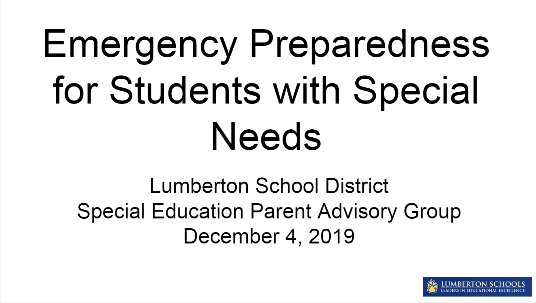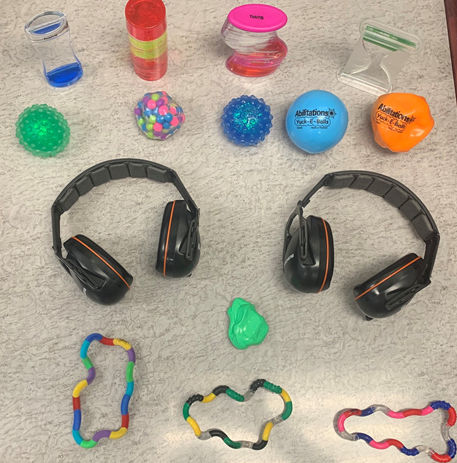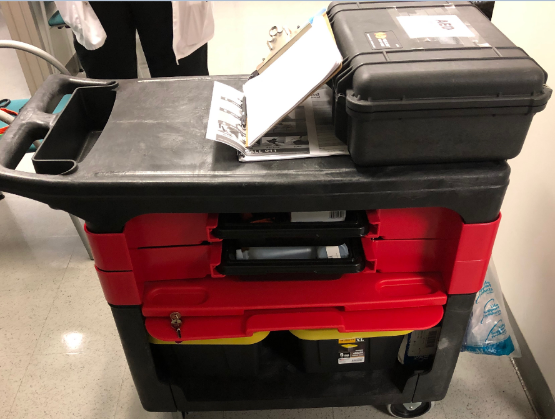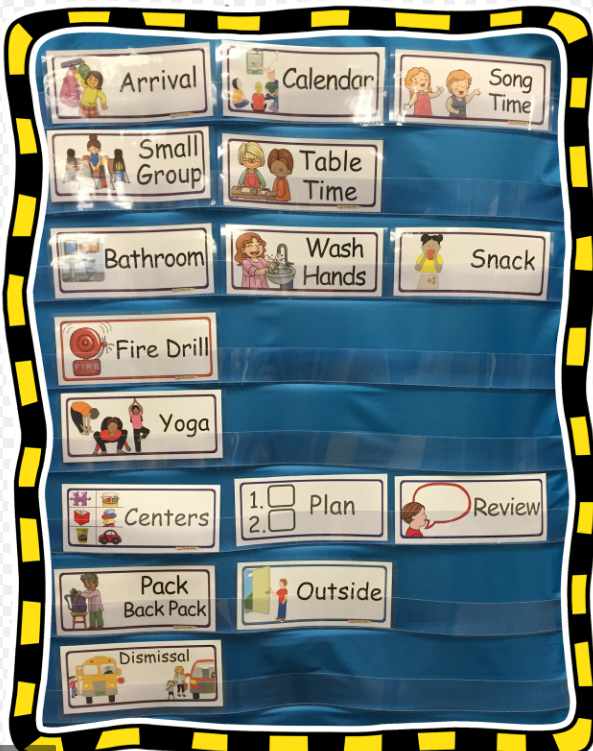- NJASA
- Community Corner Feb 2020


-
Promising Practices from the Field:
Ensuring Safety for All Students
In September 2019, the New Jersey Council on Developmental Disabilities (NJCDD) published “School Safety Issues Affecting Student with Disabilities: A Call to Action.” The report identified gaps and challenges because “there are no state or national models for promising practices related to students with disabilities.” We believe that such promising practices exist in the Lumberton Schools and throughout New Jersey districts. We are writing our “top ten” list to share some practical ideas that may add to a much needed conversation about enhancing safety for all students and staff members.
10. Involve Parents in Your Planning
New Jersey school districts are required to hold three Special Education Parent Advisory Group (SEPAG) meetings a year. This year we dedicated the December 4, 2019 meeting to the topic of emergency preparedness. Who knows more about a child’s needs than their family? Participants had an opportunity to review some of our safety practices and provide feedback and ideas. Some of these ideas will be incorporated into our safety protocols.

9. Utilize the Expertise of your Community Resources
The NJCDD article shared that “Too few schools engage local EMTs and fire marshals in planning, drills, and recovery.” This year we will include the Emergency Medical Services and fire marshall in some of our drills. We will ask them to look through the lens of providing accommodations for any students and staff needing additional assistance. This exercise will also serve to make our emergency responders more familiar with our population of students with special needs.
8. Identify Potential Vulnerabilities of Your Staff and Students
We have found it helpful to identify potential safety barriers for individual students or staff members. We have generated a list of issues that could cause an individual to be vulnerable during an emergency situation, including:
- Mobility
- Sound and Light (Sensory) Sensitivity
- Medical issues
- Social/Emotional Difficulties or Behavioral Challenges
- Visual or Hearing Impairments
- Cognitive Delays
- Communication issues, especially with English Language Learners
Developing the list of potential vulnerabilities is critical to preparing an improved individualized plan for staff and students in need.
7. Know Your Students and Staff
Based on this list, we have determined a preliminary list of skills that an individual must master in order to remain safe during a lockdown, shelter-in-place, and/or evacuation. Each factor that elevates a student’s risk during an emergency, must be considered across a variety of situations and settings.
Specific skills that will increase an individual’s chances for remaining safe during an emergency:
- Remaining quiet
- Processing and following auditory directions
- Maintaining a position, in a small, crowded space, in close proximity to others
- Regulating emotions without acting out
- Managing unexpected changes to schedules and routines
6. To Deal with Sensory Issues Create Classroom Kits
Identifying students with specific sensory needs is critical to ensuring their safety. Students who are particularly sensitive to loud noises benefit from having access to noise cancelling headphones. In addition, quiet fidget items are useful during a lockdown when students have to remain quiet and still for an extended period of time. Such items have been purchased and kits are being assembled and distributed to ensure that students have access to these items during drills and emergency situations.

5. To Address Medical Issues Utilize the Expertise of the School Nurse
Our nurses have been exceptional resources in emergency planning. Years ago the nurses would carry a “to go” bag outside during fire drills. Through Emergency Response Team (MRT) meetings and the Student Growth Objective process of the TeachNJ Act, Kathy Barbieri, Alessandra Gambino and Amy Hummel reflectively developed carts for better emergency preparedness. These have medications like Epi-pens and glucose, a portable nebulizer and albuterol. In addition, an automated external defibrillator (AED), tourniquets and general first aid supplies are included. Finally, class rosters, sign out sheets and emergency contact list for staff complete the carts. The school nurses have also been the advocates for Stop the Bleed Training for district staff.

4. To Address Behavioral Issues Define Expected vs. Unexpected Behaviors
Michelle Garcia Winner’s Social Thinking work creates a framework for supporting students in their understanding of their behaviors and the world around them. In their book Social Thinking and Me (2016), Winner and Linda K. Murphy define behavior to include our actions, our facial expressions, our words and tone of voice. Winner and Murphy further go on to outline expected and unexpected behaviors. Expected behavior is behavior that most people do in a certain place or situation, while unexpected behavior is the opposite. It is behavior that most people would not exhibit in a situation. In addition, expected behavior in one situation may be different than expected behavior in another situation.
The Social Thinking framework is an approach that is already being utilized in different settings in our district. The first step is to involve students in building their understanding of expected versus unexpected behaviors in emergency situations. For example, school staff should facilitate the following activity for each emergency scenario:
Expected Behavior During a Lockdown
Unexpected Behavior During a Lockdown
Actively engaging students in this conversation affords them the opportunity to be reflective and assists them in navigating a potentially difficult situation. Once this activity has been completed for each emergency scenario, the information should be reviewed on a regular basis so that all students are prepared for a drill or a real life emergency.
3. Identify Lagging Skills and Develop a Plan to Teach Those Lagging Skills
Building on the idea of using Michelle Garcia’s framework for expected and unexpected behaviors during emergency situations it is expected that students should remain quiet and still during a lockdown. We recognize that not all of our students have the skill set to do so. For some this requires explicit instruction and practice. This is where the concept of identifying lagging skills and developing a plan to teach those skills comes into play. The concept of lagging skills comes from the work of Dr. Ross Greene. His philosophy is that kids do well if they can. If a child isn’t doing well, then they must be lacking a critical skill that is needed in order to do well. In order to properly identify which students have lagging skills and which skills they need to focus on, we must enlist the support of our teachers, related service providers, child study team members, and parents/guardians. Not all students will require this level of individual support, most student needs can be met at the school level and the classroom level.
Some helpful tools for teaching lagging skills:
- Utilize visual supports for each scenario
- Develop social stories for different scenarios
- Review the expected versus unexpected behavior charts created for each scenario
2. Practice Frequently by Building Opportunities into the Schedule

We know that our students with the most significant needs benefit from structure and repetition throughout their school day. This holds true when building their skill set for emergency preparedness as well. Structure can be developed through more frequent practice drills at the classroom level and explicit instruction in identified lagging skills.
1. Utilize the Expertise of Your Related Services Professionals in Facility Walkthroughs
During the planning for the 2019-20 school year, we began discussing the idea of involving members of the related services team in emergency planning. An Initial meeting was arranged with Physical Therapist Deb Yuhas and Occupational Therapist Jen Gentile. From the initial meeting great ideas began to flow. The first promising practice involved facilities walkthroughs by these three staff members. While many administrative walkthroughs are focused on instructional issues, the lens on these “walks” was to identify ways to improve our safety/emergency response protocols. As intended, these walkthroughs improved our practice. In our middle school we identified a cadre of students with potential mobility issues in an evacuation. We then assigned multiple adult caregivers to each identified child to ensure additional support during events.
Final Thoughts
Together we have a collective responsibility to ensure the safety of all students and staff throughout our district. For individuals with special needs, we take great care in developing individualized plans tailored to address students’ specific academic, social/emotional and behavioral needs. However, upon starting this work, it became evident that we underestimated the importance of planning how to help these individuals acquire the skills to keep themselves safe in an emergency situation. Through reflective practice, research, collaboration and planning we have taken a more comprehensive approach that has enabled us to improve safety practices in our district. We are hopeful that these ideas might benefit all public school students and staff in their emergency planning.
References
School Safety Issues Affecting Student with Disabilities: A Call to Action https://njcdd.org/wp-content/uploads/SchoolSafetySummit_Final-1.pdf
Supporting Students With Disabilities During School Crises: A Teacher’s Guide https://www.connecticutchildrens.org/wp-content/uploads/2018/04/CCC-Supporting-Students-in-Schools.pdf
EMERGENCY PLAN FOR STUDENTS WITH SPECIAL NEEDS FOR MARIN COUNTY https://www.ssdmo.org/cool_tools/inclusive/Resources/emergency_plan.pdf
https://www.socialthinking.com/
Greene, R. W. (2014). Lost at school: why our kids with behavioral challenges are falling through the cracks and how we can help them. New York: Scribner.
Winner, M. G., & Murphy, L. K. (2016). Social thinking and me. Santa Clara, CA: Social Thinking Publishing.

